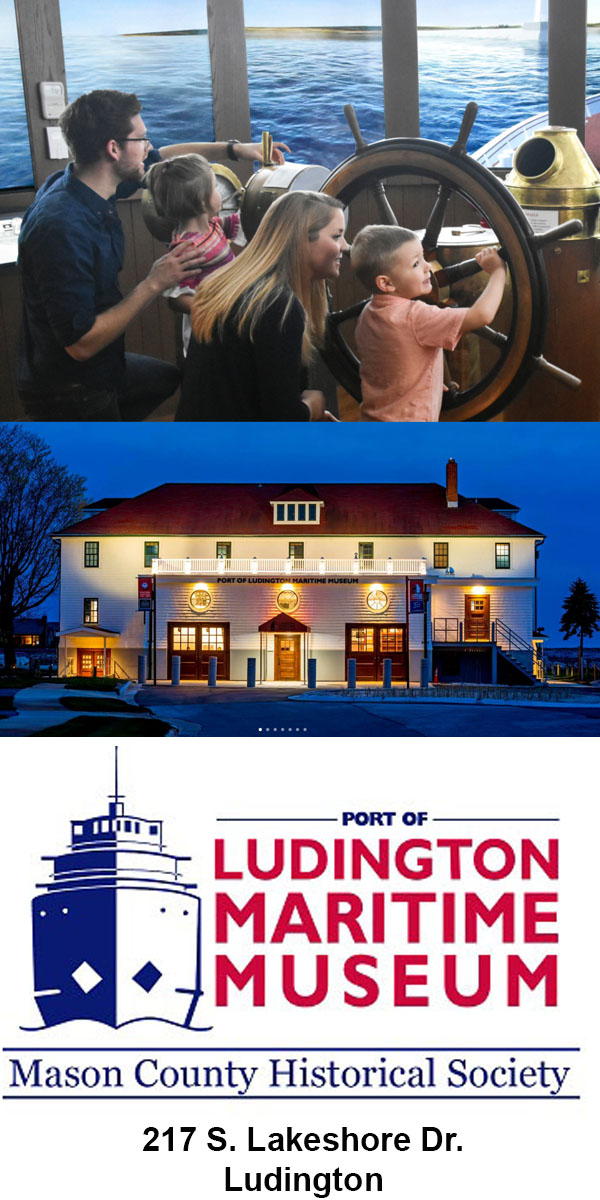
James Ludington, Ludington’s namesake.
History: The beginning of Mason County and Ludington
Part 1
This year marks the City of Ludington’s 150th anniversary, known as a sesquicentennial. Lots of celebrations are being planned. Throughout the year, MCP, in partnership with the Mason County Historical Society, will be featuring stories about Ludington’s past.

By Rob Alway, Editor-in-Chief
Before the area now known as Mason County was settled by people of European decent, it was home to Native Americans, most notably and most recently Ottawa — in the 18th and 19th centuries (and others before the Ottawa). The first written account of a non-Native American encounter near what is now Ludington happened in 1668 when Jesuit priest Father (Pere) Jacques Marquette died on the shores of Lake Michigan on what is now known as Buttersville Peninsula.
In 1673, Marquette and French-Candadian explorer Louis Jolliet, left St. Ignace and followed Lake Michigan to Green Bay, up the Fox River to its headwaters. They eventually entered the Mississippi River and traveled within 435 miles of the Gulf of Mexico, turning back at the mouth of the Arkansas River. They followed the Mississippi back to the Illinois River and reached what is now Chicago. In the spring of 1675 Marquette began his journey back to St. Ignace on the east side of Lake Michigan. He died of dysentery, at the age of 37, just south of modern Ludington. He was buried on the site but his remains were eventually moved to St. Ignace.
A century later, in 1775, as tensions were rising in the American colonies to the east, a significant conflict took place in what was later called Mason County, which resulting in the Ottawa naming the east-west river that emptied near Marquette’s death place. A battle of two or three tribes took place about 13 miles upstream near what would later become known as Custer Township. The battle resulted in a victory for the Ottawa and a warning to others, by placing the heads of the defeated on sticks along the shores of the river. As a result, the river was named Not-a-pe-ke-gon (Notipekagon), “River with Heads on Sticks.” Read more here.
The Ottawa had been established near the shores of Lake Michigan on the peninsula. Later, the village was called Nin-de-be-ke-tun-ning, meaning “Place of Skulls.”
A study by the University of Michigan archeology department found that in the early 1800s, Mason County had as many as 22 Native American villages, four burial grounds, and 15 burial mounds.
Nin-de-be-ke-tun-ning was located a short distance from what is now Historic White Pine Village. It consisted of at least 50 bark wigwams with the residents heavily engaged in fishing and farming. Feeling uncomfortable with the encroachment of white settlers, the Ottawas moved after the death of their chief, Sog-e-maw in 1845. They re-settled to government land in the southern part of Michigan.
In 1855, the U.S. government established an Indian reservation in what is now Eden and Custer townships in Mason County and Crystal and Elbridge townships in Oceana County. Many Ottawas from the Grand Rapids area relocated to this area. There are records of some Ottawas from the peninsula who also relocated to the reservation.
Read related stories here:
Eden Township’s Indian Cemetery
Resseguie School served Custer Township for over 100 years
Eden Township’s Griswolds and their legacy on local education
Good John, Leading Thunder of the Ottawa
In 1835, French-Canadian fur trapper William Quevillon came into the Buttersville area. His visit was the first recorded visit to the area by a white person since Marquette’s death. Quevillon came to Michigan with another French-Canadian, Louis Cameau, who founded Grand Rapids. Though Quevillon made his base in Grand Rapids, he had built a small trapper’s cabin on Buttersville Peninsula.
On June 16, 1840, Joseph L. Wheeler became the first person to own land in Mason County. Wheeler bought 356 acres from the federal government. His property included dense pine and hardwood forests and a large piece of waterfront property along what is now Pere Marquette Lake. His property included most of the modern Ludington Fourth Ward and west to area that is now the Ludington Municipal Marina. He acquired the land for $446.70, about $1.25 an acre. Though Wheeler did not stay in the area very long, his land played an important role in the development of the first sawmill, built by Baird and Bean in 1849. In 1847, Joseph Boyden acquired 72 acres fronting on Pere Marquette Lake.
About the same time, in 1847, Charles Mears built a mill at Black Creek, later known as Lincoln (near modern day Lincoln Hills Golf Club on Lincoln Lake in Hamlin Township). “A log house and blacksmith shop were first built.” Mears changed the name in 1861 after Abraham Lincoln was inaugurated as president.

Burr Caswell
That same year, 1847, Aaron Burr Caswell and Hannah (Green) Caswell, and their four children arrived on the shores of the Buttersville Peninsula via the schooner Eagle. The channel leading to the small lake on the other side of the peninsula (Pere Marquette Lake) was not deep enough to permit the Eagle to enter so the captain sent his passengers and their belongings ashore in a small boat. Cows and horses swam to shore.
Burr Caswell was 40-years-old and came from upper New York state. His children included Mary, 15, George, 13, Helen, 10, and Edgar, 7. Burr Caswell was born in Glens Falls, NY. He and Hannah eventually moved to the lower Mississippi Valley and then to Lake County, Illinois, north of Chicago, where he farmed for six years. Caswell first arrived in what is now Mason County in 1845, canoeing alone up the eastern shore of Lake Michigan. He spent two summers fishing in the area, setting up camps as far north as Manistee. On his return, he saw the banks of the Buttersville Peninsula and found it ideal for farming. He entered his farm on the government land register, probably in Grand Haven, and took up farming.
In 1849, the settlement on the north side of Pere Marquette Lake became known as Pere Marquette. As more sawmills were built and more settlers arrived, the settlement grew into a village, named after the river — which honored Father Marquette — that flowed into the lake and made its way out into Lake Michigan. The river was first recognized by federal maps as Pere Marquette River, as early as 1818.

The Burr Caswell house as it appeared before restoration.
From the time Michigan became a state on Jan. 26, 1837, the area now known as Mason County was part of Ottawa County. In 1855, the Michigan legislature organized Manistee, Mason and Oceana counties. Mason County was named after Stevens T. Mason, Michigan’s first governor who served from 1835 to 1840.
Originally, Mason County was divided into three townships: Free Soil, Little Sable and Pere Marquette. The first county election was held on April 2, 1855 with 41 people voting. The results included: Sheriff, Daniel Holmes (24 votes) vs. W.H. Morrison (17 votes); clerk and register, George B. Roys (26 votes) vs. Thomas Caine (15 votes); treasurer, E.G. Farnum (41 votes); coroner, W. Quivillon (41); county surveyor, John P. Sedan (25); judge of probate, Burr Caswell (22) vs. A.D. Hopkins (17); fish inspector, Burr Caswell (15). The board of canvassers included Hiram Orser, Thomas Anderson, and George B. Roys, clerk.
The first meeting of the board of supervisors (which is now known as the board of commissioners) was held at Little Sable (later called Lincoln) on Oct. 8, 1855. The first official business transacted was an order to borrow $27 from Charles Mears. Another order, that Timothy Fletcher be engaged to transfer records from the books of Ottawa County, provided he would wait a certain length of time for his pay.
At a special meeting of the county board of supervisors on Nov. 11, 1856, it was ordered that the county seat be located on the northwest quarter of the southeast quarter of section 27, town 18, north of range 18, west, which was the Burr Caswell farm on Buttersville Peninsula. Caswell’s house, a wood frame structure, was used the county courthouse. That structure continues to exist today in its original location in what is now Historic White Pine Village.

Charles Mears, 1856
The county seat at the Caswell farm didn’t last very long. Charles Mears used his influence and convinced the bounty board to hold an election in January 1861 to change the county seat to Little Sable. The vote passed.
The change caused dissatisfaction among the people who lived on the south side of the county. In 1873, a vote was held and passed to move the county seat to the newly chartered City of Ludington.
In 1864, the firm of Baird & Bean built a sawmill along the shores of Pere Marquette Lake. Charles Mears operated the mill for two or three years under a lease and changed the Pere Marquette Lake channel to a new location, the present location. Baird & Bean sold to George Farnsworth in 1849 who shortly afterwards sold the mill to George W. Ford, a Manistee lumberman. Ford’s financial troubles cost him his mill to Milwaukee businessman James Ludington in 1859.
Read more about James Ludington here.
Though the village had been called Pere Marquette, James Ludington applied his name to the post office when it was established in 1864. David A. Melendy, who was a bookkeeper for James Ludington, was the first postmaster. In 1867, James Ludington platted the village. He named several of the streets after his family members and business partners. Read more here: Ludington street namesakes tell history of town.
In January 1873, a committee was selected to create a city charter. F.F. Hopkins was appointed chairman and Samuel D. Haight was secretary. Other members of the committee were Schubael F. White, an attorney, and Peleg Ewing. In a short time, the committee drafted a charter and brought it to Lansing for the state legislature to approve. The city’s first election took place on April 7, 1873.
With the legislature’s approval on March 22, 1873, the name of the city became Ludington, but that was not necessarily a popular decision. A donation of $5,000 (valued at $124,000 in today’s money), to help with city and county buildings, by James Ludington, may have had some influence in the name becoming officially Ludington. The township, however, remained named Pere Marquette (and still is).
Please consider helping to fund local news. Mason County Press and Oceana County Press are available for free thanks to the generous support of our advertisers and individuals. Three ways to help us: Venmo: @MasonCountyPress; Paypal: MasonCountyPress@gmail.com; Mail a check to PO BOX 21, Scottville, MI 49454.
This story is copyrighted © 2023, all rights reserved by Media Group 31, LLC, PO Box 21, Scottville, MI 49454. No portion of this story or images may be reproduced in any way, including print or broadcast, without expressed written consent.
As the services of Media Group 31, LLC are news services, the information posted within the sites are archivable for public record and historical posterity. For this reason it is the policy and practice of this company to not delete postings. It is the editor’s discretion to update or edit a story when/if new information becomes available. This may be done by editing the posted story or posting a new “follow-up” story. Media Group 31, LLC or any of its agents have the right to make any changes to this policy. Refer to Use Policy for more information.





























.png)




































